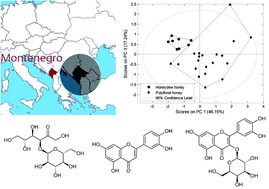Our official English website, www.x-mol.net, welcomes your feedback! (Note: you will need to create a separate account there.)
Physicochemical analysis and phenolic profile of polyfloral and honeydew honey from Montenegro
RSC Advances ( IF 3.9 ) Pub Date : 2020-1-14 , DOI: 10.1039/c9ra08783d Milica Nešović 1 , Uroš Gašić 2 , Tomislav Tosti 3 , Jelena Trifković 3 , Rada Baošić 3 , Stevan Blagojević 1 , Ljubiša Ignjatović 4 , Živoslav Tešić 3
RSC Advances ( IF 3.9 ) Pub Date : 2020-1-14 , DOI: 10.1039/c9ra08783d Milica Nešović 1 , Uroš Gašić 2 , Tomislav Tosti 3 , Jelena Trifković 3 , Rada Baošić 3 , Stevan Blagojević 1 , Ljubiša Ignjatović 4 , Živoslav Tešić 3
Affiliation

|
The research subject of this paper was a detail physicochemical analysis of 28 honey samples from the northern part of Montenegro. The honey from Montenegro has not been previously studied in such detail. Differentiation between samples, such as honeydew honey and polyfloral honey, was based on electrical conductivity, which was higher than 0.8 mS cm−1 for honeydew honey, as was expected. Other investigated physicochemical parameters (water content, free acids, diastase activity, hydroxymethylfurfural (HMF) content and sugar content) have shown great similarity for all honey samples. The main interest of this study was the identification and quantification of phenolic compounds using ultra-high performance liquid chromatography (UHPLC) with mass spectrometry detection. The results show that honey samples are very rich in phenolic compounds, especially quercetin. Among the 31 quantified phenolic compounds, the most dominant were phenolic acids. The highlight was based on p-hydroxybenzoic acid, p-coumaric acid, caffeic acid and ferulic acid. Considering polyphenolic compounds and sugar content, a high nutritional value can be observed in all samples, with an emphasis on polyfloral honeys, as was confirmed with principal component analysis (PCA). In addition, all honey samples were tested for total phenolic content (TPC) and radical scavenging activity (RSA). The results indicate the higher antioxidant ability of honeys from Montenegro in comparison to some honey samples from other countries in the region.
中文翻译:

黑山多花蜜和蜜露的理化分析及酚类成分
本文的研究主题是对来自黑山北部的 28 个蜂蜜样品进行详细的物理化学分析。来自黑山的蜂蜜以前没有被如此详细地研究过。样品之间的区别,如蜜露蜂蜜和杂花蜂蜜,是基于电导率,高于 0.8 mS cm -1正如预期的那样,对于蜜露蜂蜜。其他研究的物理化学参数(水含量、游离酸、淀粉酶活性、羟甲基糠醛 (HMF) 含量和糖含量)显示出所有蜂蜜样品的高度相似性。本研究的主要兴趣是使用具有质谱检测的超高效液相色谱 (UHPLC) 鉴定和定量酚类化合物。结果表明,蜂蜜样品中的酚类化合物非常丰富,尤其是槲皮素。在 31 种量化的酚类化合物中,最主要的是酚酸。亮点是基于对羟基苯甲酸,p-香豆酸、咖啡酸和阿魏酸。考虑到多酚化合物和糖含量,在所有样品中都可以观察到高营养价值,重点是多花蜂蜜,正如主成分分析 (PCA) 所证实的那样。此外,对所有蜂蜜样品的总酚含量 (TPC) 和自由基清除活性 (RSA) 进行了测试。结果表明,与该地区其他国家的一些蜂蜜样品相比,黑山蜂蜜的抗氧化能力更高。
更新日期:2020-01-14
中文翻译:

黑山多花蜜和蜜露的理化分析及酚类成分
本文的研究主题是对来自黑山北部的 28 个蜂蜜样品进行详细的物理化学分析。来自黑山的蜂蜜以前没有被如此详细地研究过。样品之间的区别,如蜜露蜂蜜和杂花蜂蜜,是基于电导率,高于 0.8 mS cm -1正如预期的那样,对于蜜露蜂蜜。其他研究的物理化学参数(水含量、游离酸、淀粉酶活性、羟甲基糠醛 (HMF) 含量和糖含量)显示出所有蜂蜜样品的高度相似性。本研究的主要兴趣是使用具有质谱检测的超高效液相色谱 (UHPLC) 鉴定和定量酚类化合物。结果表明,蜂蜜样品中的酚类化合物非常丰富,尤其是槲皮素。在 31 种量化的酚类化合物中,最主要的是酚酸。亮点是基于对羟基苯甲酸,p-香豆酸、咖啡酸和阿魏酸。考虑到多酚化合物和糖含量,在所有样品中都可以观察到高营养价值,重点是多花蜂蜜,正如主成分分析 (PCA) 所证实的那样。此外,对所有蜂蜜样品的总酚含量 (TPC) 和自由基清除活性 (RSA) 进行了测试。结果表明,与该地区其他国家的一些蜂蜜样品相比,黑山蜂蜜的抗氧化能力更高。


























 京公网安备 11010802027423号
京公网安备 11010802027423号